Spatiotemporal Variation and Quantitative Attribution of Carbon Storage Based on Multiple Satellite Data and a Coupled Model for Jinan City, China
Abstract
:1. Introduction
2. Materials and Methods
2.1. Study Area
2.2. Multi-Source Remote Sensing Data
2.3. Methodology
2.3.1. The Coupled Markov-FLUS Model
2.3.2. Development Scenario Setting Based on SDGs
2.3.3. InVEST Carbon Storage and Sequestration Model
2.3.4. Optimal Parameter-Based Geographical Detectors
3. Results
3.1. Model Validation and Importance of Driving Factors
3.2. The Spatial–Temporal LUCC in JNC during 2010–2030
3.2.1. LUCC Dynamics from 2010 to 2018
3.2.2. LUCC Dynamics from 2018 to 2030
3.3. Spatiotemporal Variability of Carbon Storage in JNC from 2010 to 2030
3.3.1. Carbon Storage Dynamics from 2010 to 2018
3.3.2. Carbon Storage Dynamics from 2018 to 2030
3.4. Analysis of the Factors Influencing the Changes in Carbon Storage in JNC
3.4.1. Factor Detection
3.4.2. Interaction Detection Analysis
4. Discussions
4.1. LULC Dynamics Affected by Human Activities
4.2. Impacts of LUCC on Carbon Storage from 2010 to 2030
4.3. Drivers of the Spatial Variation in Carbon Storage
4.4. Limitations and Future Perspectives
5. Conclusions
Supplementary Materials
Author Contributions
Funding
Data Availability Statement
Acknowledgments
Conflicts of Interest
References
- Lawrence, D.M.; Hurtt, G.C.; Arneth, A.; Brovkin, V.; Calvin, K.V.; Jones, A.D.; Jones, C.D.; Lawrence, P.J.; de Noblet-Ducoudré, N.; Pongratz, J. The Land Use Model Intercomparison Project (LUMIP) Contribution to CMIP6: Rationale and Experimental Design. Geosci. Model Dev. 2016, 9, 2973–2998. [Google Scholar] [CrossRef]
- Winkler, K.; Fuchs, R.; Rounsevell, M.; Herold, M. Global Land Use Changes Are Four Times Greater than Previously Estimated. Nat. Commun. 2021, 12, 2501. [Google Scholar] [CrossRef] [PubMed]
- Houghton, R.A. Revised Estimates of the Annual Net Flux of Carbon to the Atmosphere from Changes in Land Use and Land Management 1850–2000. Tellus B Chem. Phys. Meteorol. 2003, 55, 378–390. [Google Scholar]
- Cao, M.; Woodward, F.I. Dynamic Responses of Terrestrial Ecosystem Carbon Cycling to Global Climate Change. Nature 1998, 393, 249–252. [Google Scholar] [CrossRef]
- Sun, W.; Liu, X. Review on Carbon Storage Estimation of Forest Ecosystem and Applications in China. For. Ecosyst. 2020, 7, 4. [Google Scholar] [CrossRef]
- Wei, X.; Yang, J.; Luo, P.; Lin, L.; Lin, K.; Guan, J. Assessment of the Variation and Influencing Factors of Vegetation NPP and Carbon Sink Capacity under Different Natural Conditions. Ecol. Indic. 2022, 138, 108834. [Google Scholar] [CrossRef]
- Houghton, R.; Hackler, J. Emissions of Carbon from Forestry and Land-use Change in Tropical Asia. Glob. Chang. Biol. 1999, 5, 481–492. [Google Scholar] [CrossRef]
- Wu, X.; Fu, B.; Wang, S.; Song, S.; Li, Y.; Xu, Z.; Wei, Y.; Liu, J. Decoupling of SDGs Followed by Re-Coupling as Sustainable Development Progresses. Nat. Sustain. 2022, 5, 452–459. [Google Scholar] [CrossRef]
- Liang, Y.; Hashimoto, S.; Liu, L. Integrated Assessment of Land-Use/Land-Cover Dynamics on Carbon Storage Services in the Loess Plateau of China from 1995 to 2050. Ecol. Indic. 2021, 120, 106939. [Google Scholar] [CrossRef]
- Liu, X.; Wang, S.; Wu, P.; Feng, K.; Hubacek, K.; Li, X.; Sun, L. Impacts of Urban Expansion on Terrestrial Carbon Storage in China. Environ. Sci. Technol. 2019, 53, 6834–6844. [Google Scholar] [CrossRef]
- Houghton, R.A.; Skole, D.L.; Nobre, C.A.; Hackler, J.L.; Lawrence, K.T.; Chomentowski, W.H. Annual Fluxes of Carbon from Deforestation and Regrowth in the Brazilian Amazon. Nature 2000, 403, 301–304. [Google Scholar] [CrossRef]
- Wang, Y.; Zhang, Z.; Chen, X. Land Use Transitions and the Associated Impacts on Carbon Storage in the Poyang Lake Basin, China. Remote Sens. 2023, 15, 2703. [Google Scholar] [CrossRef]
- Xu, C.; Jiang, Y.; Su, Z.; Liu, Y.; Lyu, J. Assessing the Impacts of Grain-for-Green Programme on Ecosystem Services in Jinghe River Basin, China. Ecol. Indic. 2022, 137, 108757. [Google Scholar] [CrossRef]
- Wu, W.; Xu, L.; Zheng, H.; Zhang, X. How Much Carbon Storage Will the Ecological Space Leave in a Rapid Urbanization Area? Beijing-Tianjin-Hebei Urban Agglomeration. Resour. Conserv. Recycl. 2023, 189, 106774. [Google Scholar] [CrossRef]
- Zhu, G.; Qiu, D.; Zhang, Z.; Sang, L.; Liu, Y.; Wang, L.; Zhao, K.; Ma, H.; Xu, Y.; Wan, Q. Land-Use Changes Lead to a Decrease in Carbon Storage in Arid Region, China. Region, China. Ecol. Indic. 2021, 127, 107770. [Google Scholar] [CrossRef]
- Xiang, S.; Wang, Y.; Deng, H.; Yang, C.; Wang, Z.; Gao, M. Response and Multi-Scenario Prediction of Carbon Storage to Land Use/Cover Change in the Main Urban Area of Chongqing, China. Ecol. Indic. 2022, 142, 109205. [Google Scholar] [CrossRef]
- He, Y.; Ma, J.; Zhang, C.; Yang, H. Spatio-Temporal Evolution and Prediction of Carbon Storage in Guilin Based on FLUS and InVEST Models. Remote Sens. 2023, 15, 1445. [Google Scholar] [CrossRef]
- Gong, W.; Duan, X.; Sun, Y.; Zhang, Y.; Ji, P.; Tong, X.; Qiu, Z.; Liu, T. Multi-Scenario Simulation of Land Use/Cover Change and Carbon Storage Assessment in Hainan Coastal Zone from Perspective of Free Trade Port Construction. J. Clean. Prod. 2023, 385, 135630. [Google Scholar] [CrossRef]
- Lin, Z.; Peng, S. Comparison of Multimodel Simulations of Land Use and Land Cover Change Considering Integrated Constraints—A Case Study of the Fuxian Lake basin. Ecol. Indic. 2022, 142, 109254. [Google Scholar] [CrossRef]
- Xiong, N.; Yu, R.; Yan, F.; Wang, J.; Feng, Z. Land Use and Land Cover Changes and Prediction Based on Multi-Scenario Simulation: A Case Study of Qishan. Remote Sens. 2022, 14, 4041. [Google Scholar] [CrossRef]
- Liu, X.; Liang, X.; Li, X.; Xu, X.; Ou, J.; Chen, Y.; Li, S.; Wang, S.; Pei, F. A Future Land Use Simulation Model (FLUS) for Simulating Multiple Land Use Scenarios by Coupling Human and Natural Effects. Landsc. Urban Plan. 2017, 168, 94–116. [Google Scholar] [CrossRef]
- Jiang, X.; Meng, W.; Gang, X.U.; Bingwang, F.; Kun, Q.I.N.; Rui, X. Urban Development Boundary Simulation Based on “Double Evaluation” and FLUS Model. J. Geod. Geoinf. Sci. 2022, 5, 7–18. [Google Scholar]
- Zhang, J.; Li, X.; Zhang, C.; Yu, L.; Wang, J.; Wu, X.; Hu, Z.; Zhai, Z.; Li, Q.; Wu, G. Assessing Spatiotemporal Variations and Predicting Changes in Ecosystem Service Values in the Guangdong-Hong Kong-Macao Greater Bay Area. gISci. Remote Sens. 2022, 59, 184–199. [Google Scholar] [CrossRef]
- Babbar, D.; Areendran, G.; Sahana, M.; Sarma, K.; Raj, K.; Sivadas, A. Assessment and Prediction of Carbon Sequestration Using Markov Chain and InVEST Model in Sariska Tiger Reserve, India. J. Clean. Prod. 2021, 278, 123333. [Google Scholar] [CrossRef]
- Zhao, M.; He, Z.; Du, J.; Chen, L.; Lin, P.; Fang, S. Assessing the Effects of Ecological Engineering on Carbon Storage by Linking the CA-Markov and InVEST Models. Ecol. Indic. 2019, 98, 29–38. [Google Scholar] [CrossRef]
- Aitali, R.; Snoussi, M.; Kolker, A.S.; Oujidi, B.; Mhammdi, N. Effects of Land Use/Land Cover Changes on Carbon Storage in North African Coastal Wetlands. J. Mar. Sci. Eng. 2022, 10, 364. [Google Scholar] [CrossRef]
- Song, Y.; Wang, J.; Ge, Y.; Xu, C. An Optimal Parameters-Based Geographical Detector Model Enhances Geographic Characteristics of Explanatory Variables for Spatial Heterogeneity Analysis: Cases with Different Types of Spatial Data. gISci. Remote Sens. 2020, 57, 593–610. [Google Scholar] [CrossRef]
- Chen, W.; Wang, G.; Zeng, J. Impact of Urbanization on Ecosystem Health in Chinese Urban Agglomerations. Environ. Impact Assess. Rev. 2023, 98, 106964. [Google Scholar] [CrossRef]
- Li, K.; Hou, Y.; Andersen, P.S.; Xin, R.; Rong, Y.; Skov-Petersen, H. An Ecological Perspective for Understanding Regional Integration Based on Ecosystem Service Budgets, Bundles, and Flows: A Case Study of the Jinan Metropolitan Area in China. J. Environ. Manag. 2022, 305, 114371. [Google Scholar] [CrossRef]
- Wang, X.; Sun, Y.; Liu, Q.; Zhang, L. Construction and Optimization of Ecological Network Based on Landscape Ecological Risk Assessment: A Case Study. Land 2023, 12, 743. [Google Scholar] [CrossRef]
- Liu, P.; Hu, Y.; Jia, W. Land Use Optimization Research Based on FLUS Model and Ecosystem Services-Setting Jinan City as an Example. Urban Clim. 2021, 40, 100984. [Google Scholar] [CrossRef]
- Li, Y.; Geng, H. Spatiotemporal Trends in Ecosystem Carbon storage Evolution and Quantitative Attribution in a Karst Watershed in Southwest China. Ecol. Indic. 2023, 153, 110429. [Google Scholar] [CrossRef]
- Alam, S.A.; Starr, M.; Clark, B.J. Tree Biomass and Soil Organic Carbon Densities across the Sudanese Woodland Savannah: A Regional Carbon Sequestration Study. J. Arid. Environ. 2013, 89, 67–76. [Google Scholar] [CrossRef]
- Guo, W.; Teng, Y.; Yan, Y.; Zhao, C.; Zhang, W.; Ji, X. Simulation of Land Use and Carbon Storage Evolution in Multi-Scenario: A Case Study in Beijing. Sustainability 2022, 14, 13436. [Google Scholar] [CrossRef]
- Wang, C.; Luo, J.; Qing, F.; Tang, Y.; Wang, Y. Analysis of the Driving Force of Spatial and Temporal Differentiation of Carbon Storage in Taihang Mountains Based on InVEST Model. Appl. Sci. 2022, 12, 10662. [Google Scholar] [CrossRef]
- Xiang, M.; Wang, C.; Tan, Y.; Yang, J.; Duan, L.; Fang, Y.; Li, W.; Shu, Y.; Liu, M. Spatio-Temporal Evolution and Driving Factors of Carbon Storage in the Western Sichuan Plateau. Sci. Rep. 2022, 12, 8114. [Google Scholar] [CrossRef] [PubMed]
- Eddy, S.R. Profile Hidden Markov Models. Bioinformatics 1998, 14, 755–763. [Google Scholar] [CrossRef]
- Eddy, S.R. Hidden Markov Models. Curr. Opin. Struct. Biol. 1996, 6, 361–365. [Google Scholar] [CrossRef]
- Firozjaei, M.K.; Sedighi, A.; Argany, M.; Jelokhani-Niaraki, M.; Arsanjani, J.J. A Geographical Direction-Based Approach for Capturing the Local Variation of Urban Expansion in the Application of CA-Markov Model. Cities 2019, 93, 120–135. [Google Scholar] [CrossRef]
- Zhang, Y.; Chang, X.; Liu, Y.; Lu, Y.; Wang, Y.; Liu, Y. Urban Expansion Simulation under Constraint of Multiple Ecosystem Services (MESs) Based on Cellular Automata (CA)-Markov Model: Scenario Analysis and Policy Implications. Land Use Policy 2021, 108, 105667. [Google Scholar] [CrossRef]
- Zhou, L.; Dang, X.; Sun, Q.; Wang, S. Multi-Scenario Simulation of Urban Land Change in Shanghai by Random Forest and CA-Markov Model. Cities Soc. 2020, 55, 102045. [Google Scholar] [CrossRef]
- Wang, S.Q.; Zheng, X.Q.; Zang, X.B. Accuracy Assessments of Land Use Change Simulation Based on Markov-Cellular Automata Model. Procedia Environ. Sci. 2012, 13, 1238–1245. [Google Scholar] [CrossRef]
- Liang, X.; Liu, X.; Li, X.; Chen, Y.; Tian, H.; Yao, Y. Delineating Multi-Scenario Urban Growth Boundaries with a CA-Based FLUS Model and Morphological Method. Landsc. Urban Plan. 2018, 177, 47–63. [Google Scholar] [CrossRef]
- Sharp, R.; Douglass, J.; Wolny, S.; Arkema, K.; Bernhardt, J.; Bierbower, W.; Chaumont, N.; Denu, D.; Fisher, D.; Glowinski, K.; et al. VEST 3.9.0 User’s Guide; The Natural Capital Project, Stanford University, University of Minnesota, The Nature Conservancy, and World Wildlife Fund, 2020. [Google Scholar]
- Fu, Q.; Xu, L.; Zheng, H.; Chen, J. Spatiotemporal Dynamics of Carbon Storage in Response to Urbanization: A Case Study in the Su-Xi-Chang Region, China. Processes 2019, 7, 836. [Google Scholar] [CrossRef]
- Liu, J.; Xu, Q.; Yi, J.; Huang, X. Analysis of the Heterogeneity of Urban Expansion Landscape Patterns and Driving Factors Based on a Combined Multi-Order Adjacency Index and Geodetector Model. Ecol. Indic. 2022, 136, 108655. [Google Scholar] [CrossRef]
- Wang, J.; Xu, C. Geodetector: Principle and Prospective. Acta Geogr. Sin. 2017, 72, 116–134. [Google Scholar]
- Gong, C.; Wang, L.; Wang, S.-X.; Zhang, Z.-X.; Dong, H.; Liu, J.-F.; Wang, D.-W.; Yan, B.-Q.; Chen, Y. Spatial Differentiation and Influencing Factor Analysis of Soil Heavy Metal Content at Town Level Based on Geographic Detector. Huan Jing Ke Xue Huanjing Kexue 2022, 43, 4566–4577. [Google Scholar]
- Aguilera, M.A.; Tapia, J.; Gallardo, C.; Núñez, P.; Varas-Belemmi, K. Loss of Coastal Ecosystem Spatial Connectivity and Services by Urbanization. Natural-to-Urban Integration for Bay Management. J. Environ. Manag. 2020, 276, 111297. [Google Scholar] [CrossRef] [PubMed]
- Rimal, B.; Sharma, R.; Kunwar, R.; Keshtkar, H.; Stork, N.E.; Rijal, S.; Rahman, S.A.; Baral, H. Effects of Land Use and Land Cover Change on Ecosystem Services in the Koshi River Basin, Eastern Nepal. Ecosyst. Serv. 2019, 38, 100963. [Google Scholar] [CrossRef]
- Zeng, J.; Cui, X.; Chen, W.; Yao, X. Impact of Urban Expansion on the Supply-Demand Balance of Ecosystem Services: An Analysis of Prefecture-Level Cities in China. Environ. Impact Assess. Rev. 2023, 99, 107003. [Google Scholar] [CrossRef]
- Zou, L.; Liu, Y.; Wang, J.; Yang, Y.; Wang, Y. Land Use Conflict Identification and Sustainable Development Scenario Simulation on China. J. Clean. Prod. 2019, 238, 117899. [Google Scholar] [CrossRef]
- Wang, C.; Zhan, J.; Chu, X.; Liu, W.; Zhang, F. Variation in Ecosystem Services with Rapid Urbanization: A Study of Carbon Sequestration in the Beijing. Phys. Chem. Earth Parts A/B/C 2019, 110, 195–202. [Google Scholar] [CrossRef]
- Zhu, L.; Song, R.; Sun, S.; Li, Y.; Hu, K. Land Use/Land Cover Change and Its Impact on Ecosystem Carbon Storage in Coastal Areas of China from 1980 to 2050. Ecol. Indic. 2022, 142, 109178. [Google Scholar] [CrossRef]
- Xin, X.; Zhang, T.; He, F.; Zhang, W.; Chen, K. Assessing and Simulating Changes in Ecosystem Service Value Based on Land Use/Cover Change in Coastal Cities: A Case Study of Shanghai, China. Ocean Coast. Manag. 2023, 239, 106591. [Google Scholar] [CrossRef]
- Ding, K.; Huang, Y.; Wang, C.; Li, Q.; Yang, C.; Fang, X.; Tao, M.; Xie, R.; Dai, M. Time Series Analysis of Land Cover Change Using Remotely Sensed and Multisource Urban Data Based on Machine Learning: A Case Study of Shenzhen, China from 1979 to 2022. Remote Sens. 2022, 14, 5706. [Google Scholar] [CrossRef]
- Junqia, K.; Du, Z.; Rong, Y.; Yongzhong, S. Prediction of Land Use Change and Its Influence on Carbon storages in the Middle Reaches of Heihe River. J. Desert Res. 2019, 39, 87. [Google Scholar]
- Zheng, H.; Zheng, H. Assessment and Prediction of Carbon Storage Based on Land Use/Land Cover Dynamics in the Coastal Area of Shandong Province. Ecol. Indic. 2023, 153, 110474. [Google Scholar] [CrossRef]
- Xiang, S.; Zhang, Q.; Wang, D.; Wang, S. Response and Vulnerability Analysis of Carbon Storage to LUCC in the Main Urban Area of Chongqing during 2000. J. Nat. Resour. 2022, 37, 1198–1213. [Google Scholar]
- Liu, M.; Han, G.; Zhang, Q. Effects of Agricultural Abandonment on Soil Aggregation, Soil Organic Carbon Storage and Stabilization: Results from observation in a small karst catchment, Southwest China. Agric. Ecosyst. Environ. 2020, 288, 106719. [Google Scholar] [CrossRef]
- Seitz, D.; Fischer, L.M.; Dechow, R.; Wiesmeier, M.; Don, A. The Potential of Cover Crops to Increase Soil Organic Carbon Storage in German Croplands. Plant Soil 2022, 488, 157–173. [Google Scholar] [CrossRef]
- Wang, R.; Zhang, H.; Qiang, W.; Li, F.; Peng, J. Spatial Characteristics and Influencing Factors of Carbon Emissions in County-Level Cities of China Based on Urbanization. Prog. Geogr 2021, 40, 1999–2010. [Google Scholar] [CrossRef]
- Wang, J.; Li, L.; Li, Q.; Wang, S.; Liu, X.; Li, Y. The Spatiotemporal Evolution and Prediction of Carbon Storage in the Yellow River Basin Based on the Major Function-Oriented Zone Planning. Sustainability 2022, 14, 7963. [Google Scholar] [CrossRef]
- Yang, Y.; Liu, L.; Zhang, P.; Wu, F.; Wang, Y.; Xu, C.; Zhang, L.; An, S.; Kuzyakov, Y. Large-Scale Ecosystem Carbon storages and Their Driving Factors across Loess Plateau. Carb Neutrality 2023, 2, 5. [Google Scholar] [CrossRef]
- Piao, S.; Fang, J.; Ciais, P.; Peylin, P.; Huang, Y.; Sitch, S.; Wang, T. The Carbon Balance of Terrestrial Ecosystems in China. Nature 2009, 458, 1009–1013. [Google Scholar] [CrossRef]
- Gao, M.; Xu, R.; Huang, J.; Su, B.; Jiang, S.; Shi, P.; Yang, H.; Xing, Y.; Wang, D.; Jiang, H.; et al. Increase of Carbon Storage in the Qinghai-Tibet Plateau: Perspective from Land-Use Change under Global Warming. J. Clean. Prod. 2023, 414, 137540. [Google Scholar] [CrossRef]
- Kong, R.; Zhang, Z.; Huang, R.; Tian, J.; Feng, R.; Chen, X. Projected Global Warming-Induced Terrestrial Ecosystem Carbon across China under SSP Scenarios. Ecol. Indic. 2022, 139, 108963. [Google Scholar] [CrossRef]
- Lal, R. Soil Carbon Sequestration Impacts on Global Climate Change and Food Security. Science 2004, 304, 1623–1627. [Google Scholar] [CrossRef] [PubMed]
- Luo, P.; Zhou, M.; Deng, H.; Lyu, J.; Cao, W.; Takara, K.; Nover, D.; Schladow, S.G. Impact of Forest Maintenance on Water Shortages: Hydrologic Modeling and Effects of Climate Change. Sci. Total Environ. 2018, 615, 1355–1363. [Google Scholar] [CrossRef]
- He, Y.; Kuang, Y.; Zhao, Y.; Ruan, Z. Spatial Correlation between Ecosystem Services and Human Disturbances: A Case Study of the Guangdong-Hong Kong-Macao Greater Bay Area, China. Remote Sens. 2021, 13, 1174. [Google Scholar] [CrossRef]
- Cao, Z.; Zhu, W.; Luo, P.; Wang, S.; Tang, Z.; Zhang, Y.; Guo, B. Spatially Non-Stationary Relationships between Changing Environment and Water Yield Services in Watersheds of China’s Climate Transition Zones. Remote Sens. 2022, 14, 5078. [Google Scholar] [CrossRef]
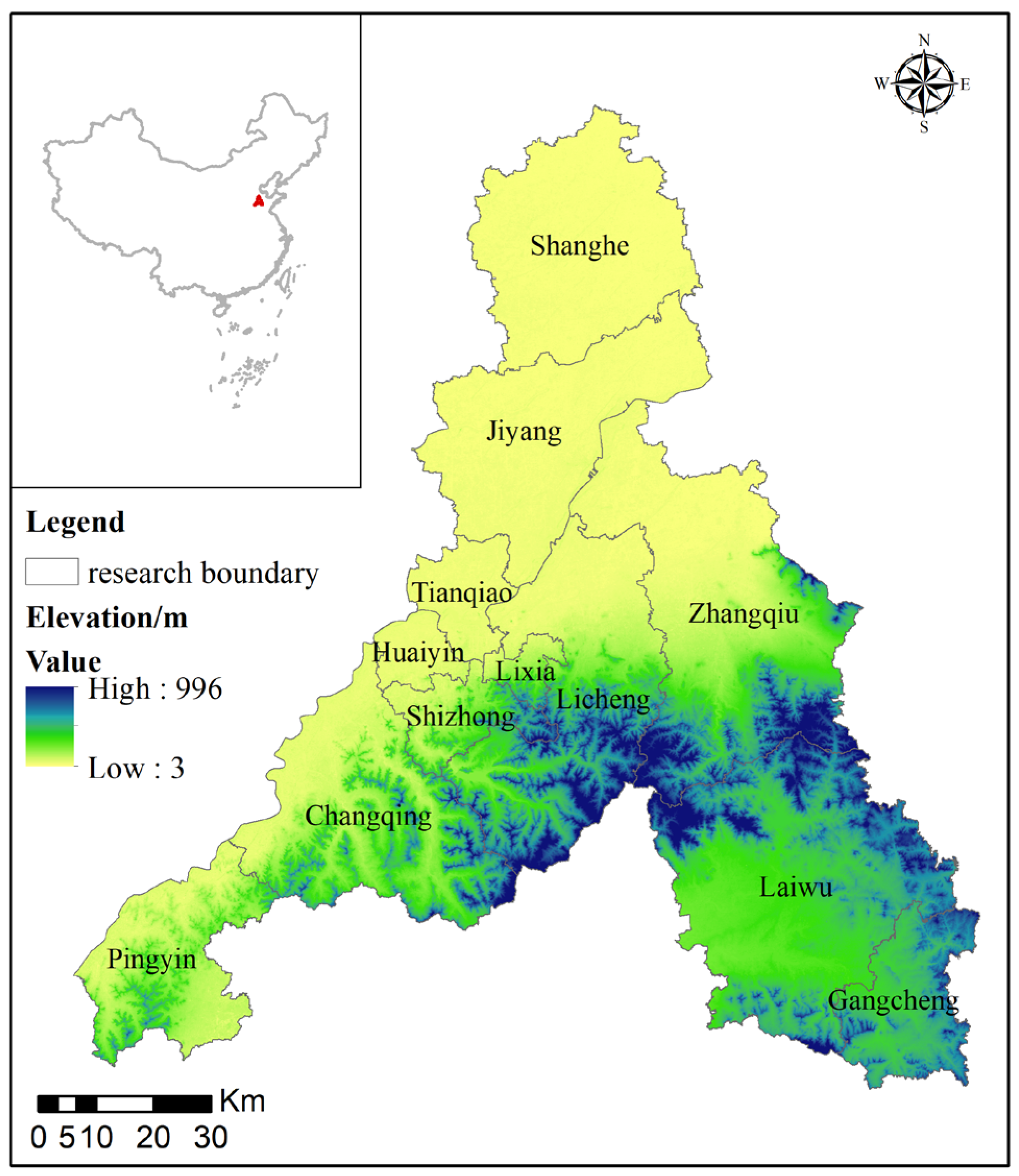
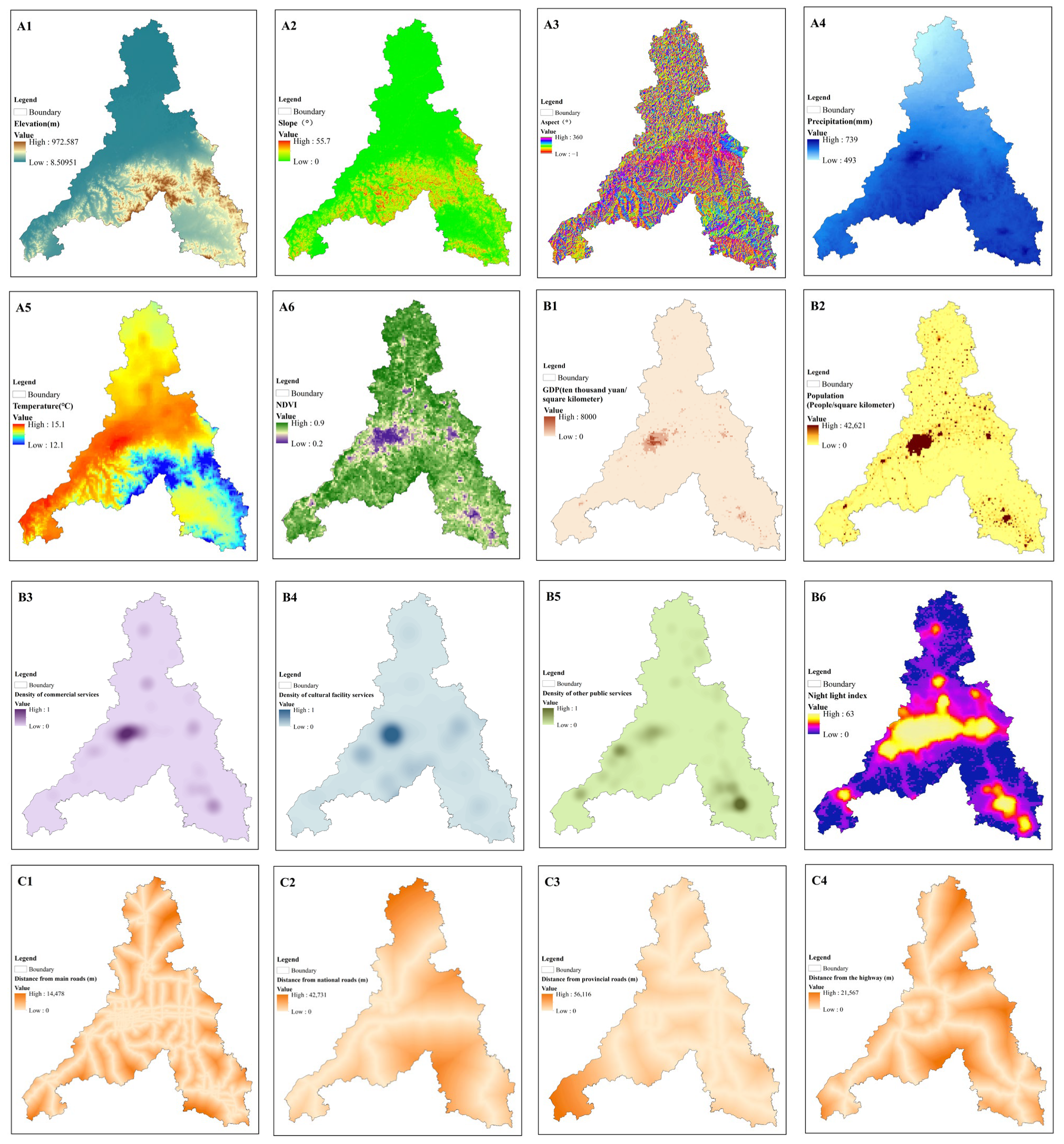
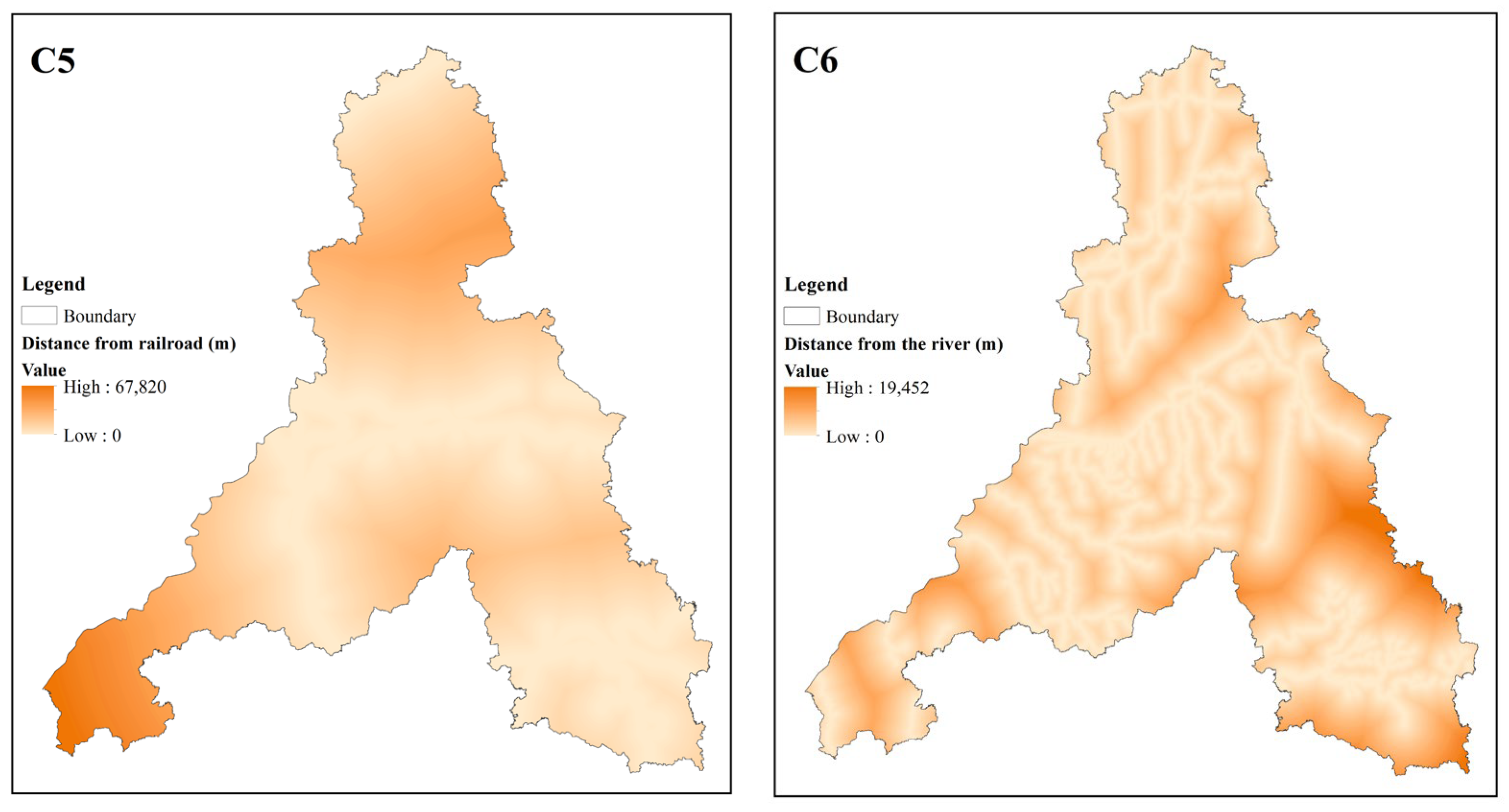
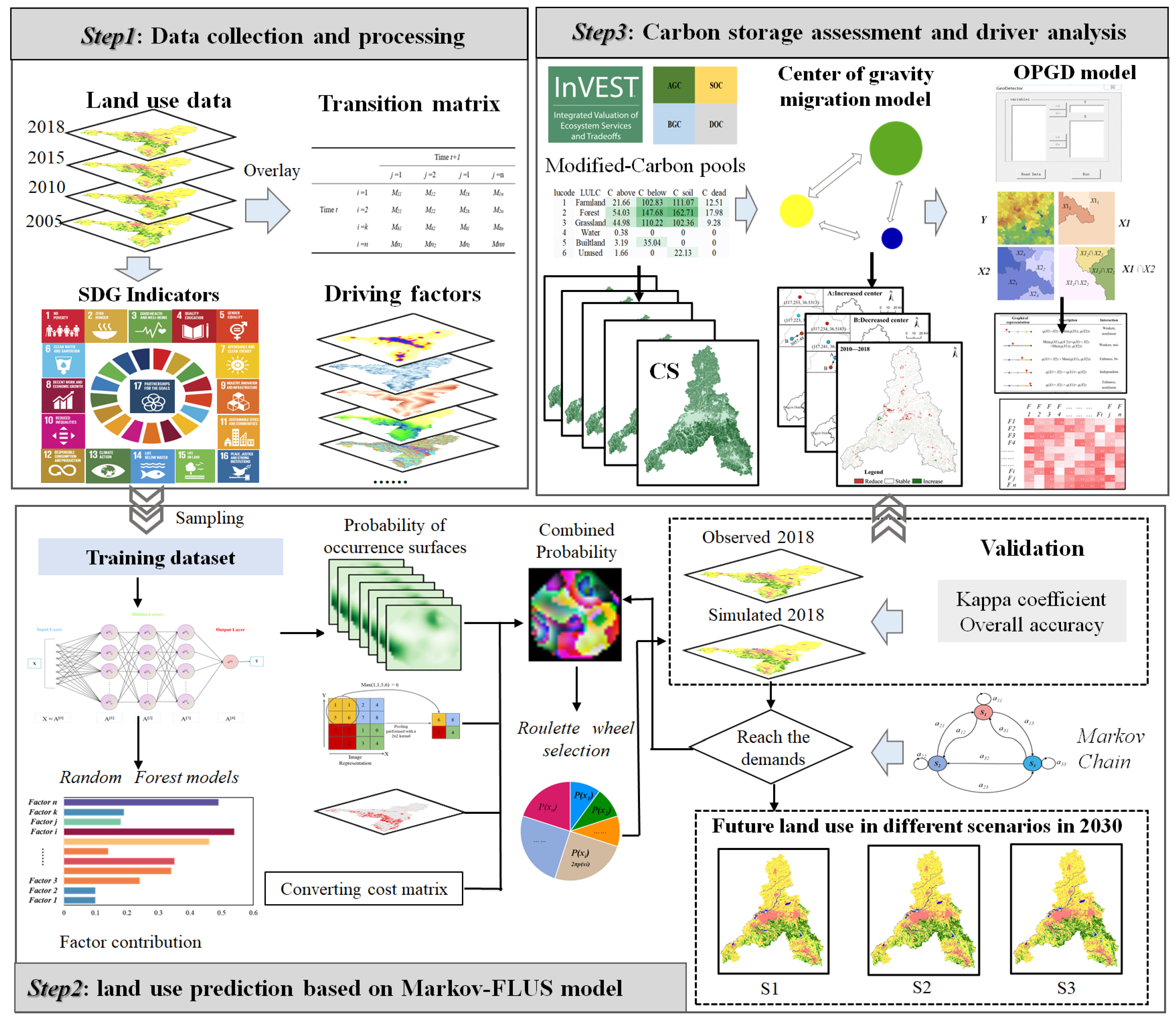


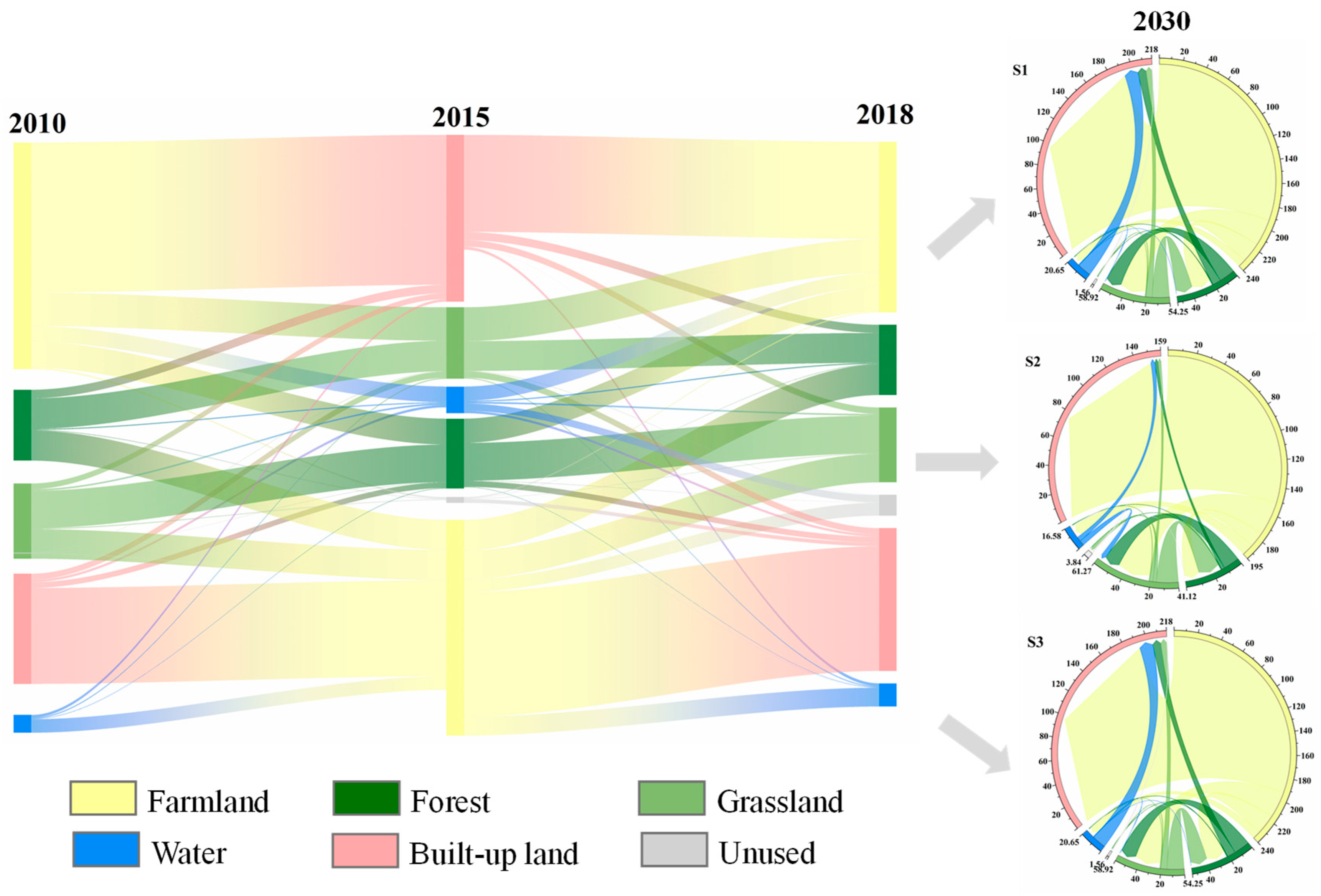
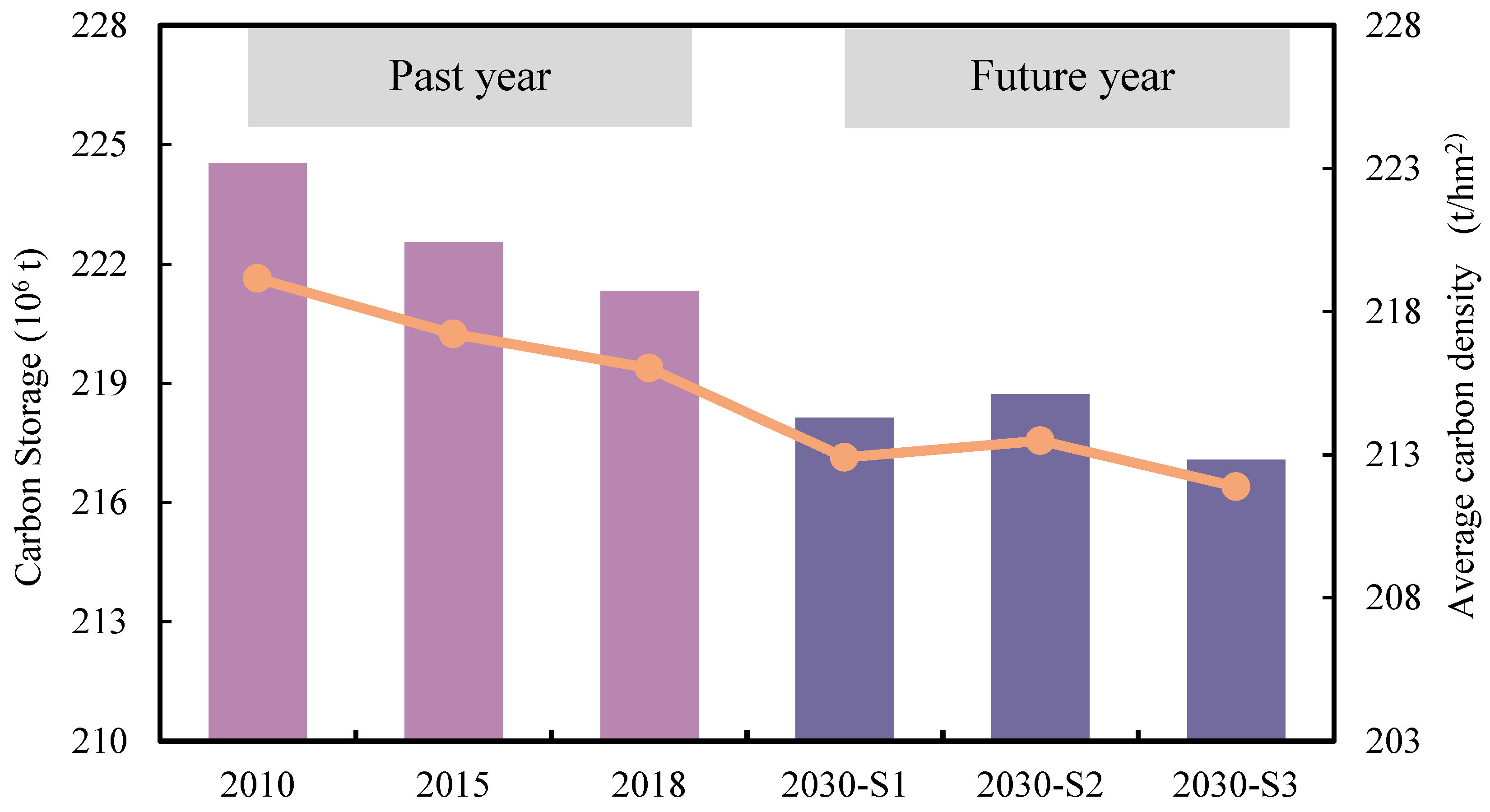
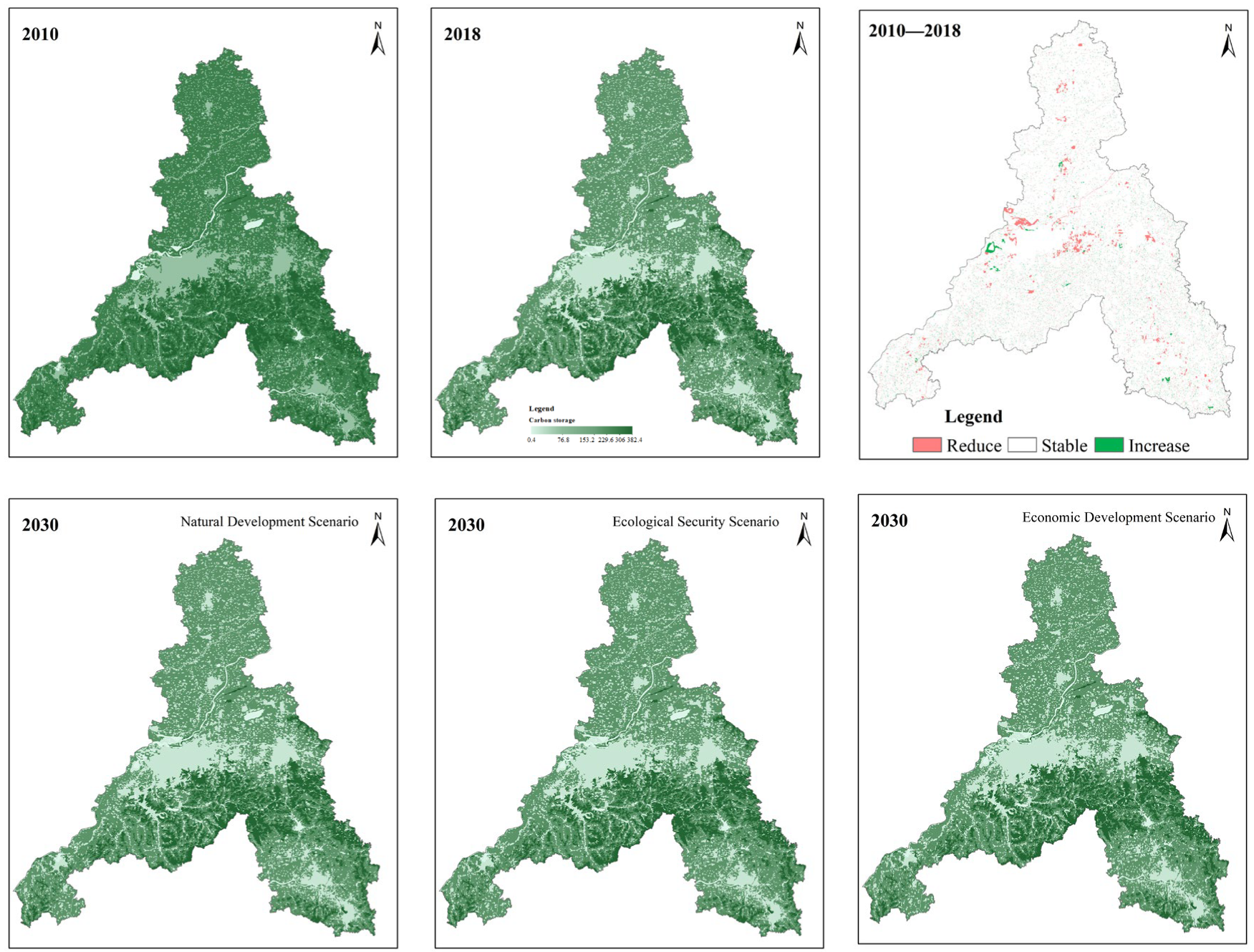
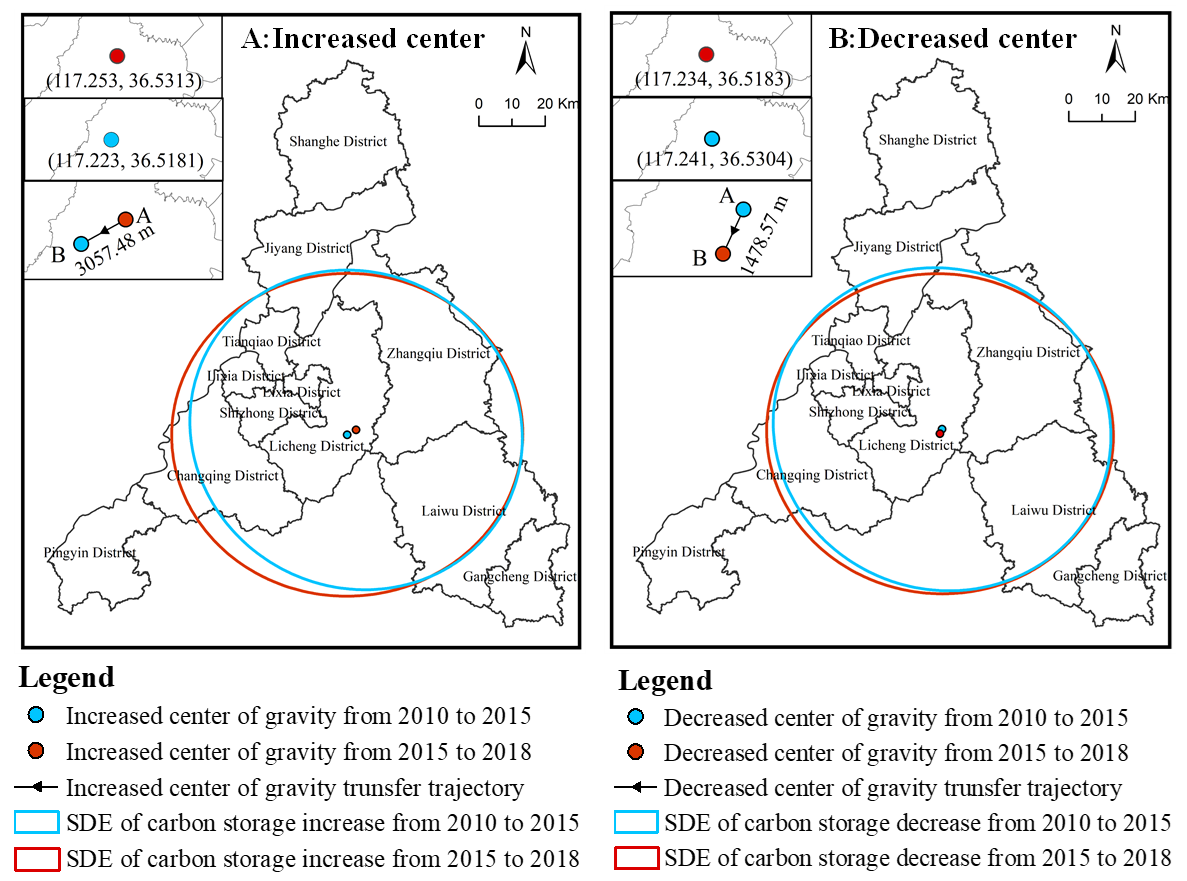
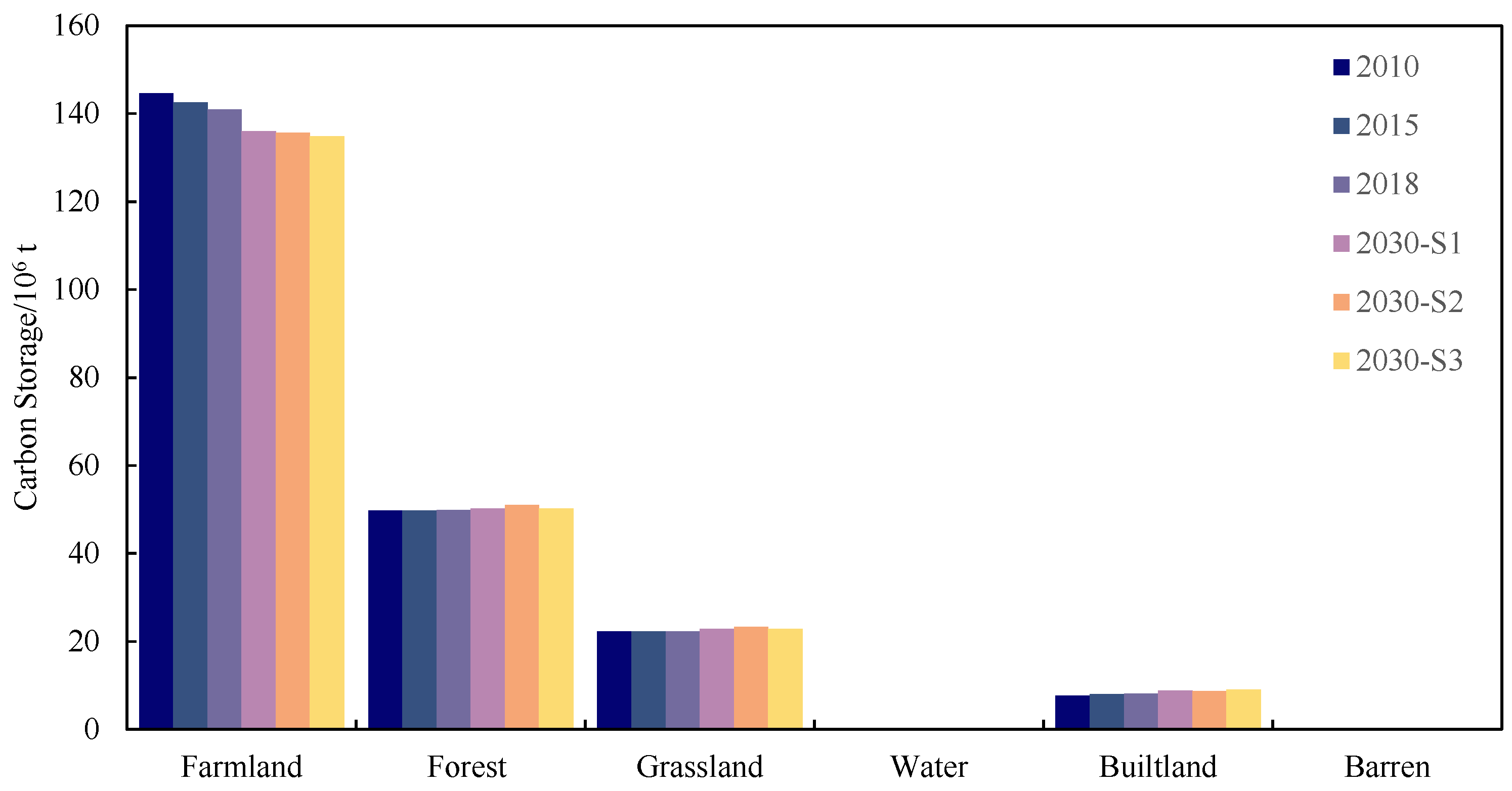


| All Scenarios | Farmland | Forest | Grassland | Water | Built Land | Unused Land |
|---|---|---|---|---|---|---|
| S1 | 5483.73 | 1315.25 | 857.16 | 233.78 | 2297.36 | 57.84 |
| S2 | 5465.65 | 1332.64 | 875.05 | 242.47 | 2271.50 | 57.81 |
| S3 | 5438.78 | 1313.05 | 854.73 | 233.45 | 2356.65 | 48.47 |
| Lucc Type | Ci-above | Ci-below | Ci-soil | Ci-dead |
|---|---|---|---|---|
| Farmland | 21.66 | 102.83 | 111.07 | 12.51 |
| Forest | 54.03 | 147.68 | 162.71 | 17.98 |
| Grassland | 44.98 | 110.22 | 102.36 | 9.28 |
| Water | 0.38 | 0 | 0 | 0 |
| Built-up land | 3.19 | 35.04 | 0 | 0 |
| Unused land | 1.66 | 0 | 22.13 | 0 |
| Types of Interactions | Range of q Values |
|---|---|
| Non-linear weakening | q(X1∩X2) < Min[q(X1), q(X2)] |
| Single-linear weakening | Min[q(X1), q(X2)] < q(X1∩X2) < Max[q(X1), q(X2)] |
| Two-factor enhancement | Max[q(X1), q(X2)] < q(X1∩X2) < q(X1) + q(X2) |
| Mutually independent | q(X1∩X2) = q(X1) + q(X2) |
| Non-linear enhancement | q(X1∩X2) > q(X1) + q(X2) |
| 2010 | 2015 | 2018 | 2030-S1 | 2030-S2 | 2030-S3 | |
|---|---|---|---|---|---|---|
| Farmland | 5831.71 | 5746.44 | 5678.64 | 5483.73 | 5465.65 | 5438.78 |
| Forest | 1301.55 | 1300.11 | 1302.67 | 1315.25 | 1332.64 | 1313.05 |
| Grassland | 838.04 | 832.56 | 838.09 | 857.16 | 875.05 | 854.73 |
| Water | 248.08 | 252.65 | 247.51 | 233.78 | 242.47 | 233.45 |
| Built-up land | 2011.24 | 2096.25 | 2138.49 | 2297.36 | 2271.50 | 2356.65 |
| Unused | 14.5 | 17.11 | 39.72 | 57.84 | 57.81 | 48.47 |
| Total | 10,245.12 | 10,245.12 | 10,245.12 | 10,245.12 | 10,245.12 | 10,245.12 |
| Type of Conversion | S1 | S2 | S3 |
|---|---|---|---|
| Farmland–Forest land | 148.17 | 446.11 | 232.79 |
| Farmland–Grassland | 46.06 | 75.57 | 43.73 |
| Farmland–Built-up land | −3170.68 | −2690.57 | −4042.99 |
| Forest land–Grassland | −133.13 | −267.06 | −161.67 |
| Forest land–Built-up land | −82.94 | −92.93 | −255.03 |
| Forest land–Unused | −5.74 | −16.14 | −6.81 |
| Grassland–Forest land | 182.24 | 268.21 | 173.34 |
| Grassland–Built-up land | −54.64 | −51.44 | −123.45 |
| Grassland–Unused | −61.98 | −17.50 | −11.91 |
| Unused–Forest land | 1.79 | 4.66 | 0.36 |
| Unused–Grassland | 8.51 | 3.40 | 1.94 |
| Unused–Built-up land | 0.03 | 0.00 | 0.49 |
| Carbon losses | −3509.11 | −3135.63 | −4601.86 |
| Carbon sinks | 386.794 | 797.957 | 452.662 |
| Total change | −3122.31 | −2337.67 | −4149.20 |
Disclaimer/Publisher’s Note: The statements, opinions and data contained in all publications are solely those of the individual author(s) and contributor(s) and not of MDPI and/or the editor(s). MDPI and/or the editor(s) disclaim responsibility for any injury to people or property resulting from any ideas, methods, instructions or products referred to in the content. |
© 2023 by the authors. Licensee MDPI, Basel, Switzerland. This article is an open access article distributed under the terms and conditions of the Creative Commons Attribution (CC BY) license (https://creativecommons.org/licenses/by/4.0/).
Share and Cite
Lu, L.; Xue, Q.; Zhang, X.; Qin, C.; Jia, L. Spatiotemporal Variation and Quantitative Attribution of Carbon Storage Based on Multiple Satellite Data and a Coupled Model for Jinan City, China. Remote Sens. 2023, 15, 4472. https://doi.org/10.3390/rs15184472
Lu L, Xue Q, Zhang X, Qin C, Jia L. Spatiotemporal Variation and Quantitative Attribution of Carbon Storage Based on Multiple Satellite Data and a Coupled Model for Jinan City, China. Remote Sensing. 2023; 15(18):4472. https://doi.org/10.3390/rs15184472
Chicago/Turabian StyleLu, Lu, Qiang Xue, Xiaojing Zhang, Changbo Qin, and Lizhi Jia. 2023. "Spatiotemporal Variation and Quantitative Attribution of Carbon Storage Based on Multiple Satellite Data and a Coupled Model for Jinan City, China" Remote Sensing 15, no. 18: 4472. https://doi.org/10.3390/rs15184472
APA StyleLu, L., Xue, Q., Zhang, X., Qin, C., & Jia, L. (2023). Spatiotemporal Variation and Quantitative Attribution of Carbon Storage Based on Multiple Satellite Data and a Coupled Model for Jinan City, China. Remote Sensing, 15(18), 4472. https://doi.org/10.3390/rs15184472







